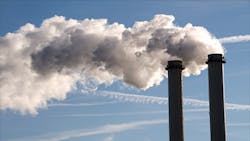U.S. emissions of carbon dioxide blamed for climate change fell in 2011 and have slipped to a 20-year low this year as the world's largest economy uses more natural gas and less coal, data shows.
The surprise drop from the world's second biggest emitter comes despite the lack of legislation on climate change but it was unclear if the change marked a trend or would be enough to meet goals on fighting global warming.
Official data showed that energy-related U.S. carbon emissions fell by 2.4% in 2011 from the previous year.
The decline did not fully track the broader economy as the United States posted growth in 2011, whereas the last time emissions declined was in 2009 during a contraction in the economy.
In the first three months of 2012, U.S. carbon emissions from energy use were down by almost 8% from the same period last year, marking the lowest level for the quarter since 1992, the Energy Information Administration said.
The government agency said that the drop in emissions in the first quarter was due in part to the warmer winter, which decreased the need for heating during the season that traditionally sees the most energy demand.
The quarter saw the lowest level since 1983 in carbon emissions generated by coal, which is the dirtiest major source of energy. In 2011, coal accounted for 43% of U.S. power generation, down from 51% in 2005.
"The decline in coal-related emissions is due mainly to utilities using less coal for electricity generation as they burned more low-priced natural gas," said the report issued this month.
Hydraulic Fracturing Boom
The supply of natural gas has soared due to a boom in hydraulic fracturing, or "fracking" -- high-pressure injections of water, sand and chemicals deep into the earth to blast through rock and release gas and oil.
Advocates say that fracking has the potential to reduce U.S. emissions and imports, but environmentalists have voiced concern that the process can contaminate water supplies. Governments including France and the U.S. state of Vermont have banned fracking.
The U.S. data showed that some 18% of U.S. energy consumption in 2011 came from sources that do not emit any carbon dioxide including nuclear, hydropower, wind and solar energy.
The Energy Information Administration warned that it was "difficult to draw conclusions" from data due to specific factors in 2011, including a large increase in hydropower generation.
But it said that other factors -- including the abundance of natural gas and improvements in fuel efficiency of vehicles -- could make a longer-term impact.
In a projection made in June, the agency estimated that U.S. carbon emissions would be more than 9% below 2005 levels in 2020 assuming no national regulations other than vehicle emission standards.
Government Initiatives
President Barack Obama promised ahead of the turbulent UN climate summit in Copenhagen in 2009 that the United States would cut emissions by 17% by 2020 from 2005 levels, in a shift from his climate-skeptic predecessor George W. Bush.
But proposals backed by Obama to restrict carbon emissions have died in Congress. Lawmakers of the rival Republican Party are staunchly opposed, arguing that climate efforts are too costly and voicing doubt about scientists' views on climate change.
International negotiations have also deadlocked. China, the world's largest emitter, has vowed to reduce the intensity of its emissions but rejects a binding treaty.
The planet has been experiencing extreme weather, droughts and record temperatures that many scientists link to climate change. The continental United States this year experienced a spring that was the warmest on record at 5.2 degrees Fahrenheit (2.9 Celsius) above the average from 1901 to 2000.
- Shaun Tandon, AFP
Copyright Agence France-Presse, 2012
About the Author
Agence France-Presse
Copyright Agence France-Presse, 2002-2025. AFP text, photos, graphics and logos shall not be reproduced, published, broadcast, rewritten for broadcast or publication or redistributed directly or indirectly in any medium. AFP shall not be held liable for any delays, inaccuracies, errors or omissions in any AFP content, or for any actions taken in consequence.
